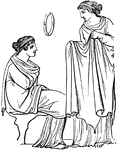Clipart tagged: ‘Peplum’

Peplum
"An outer garment, strictly worn by females, and thus corresponding to the himation or pallium, the…

Layered Skirt
This layered skirt is a late 19th century design shown in its front and back view. It has a peplum over…